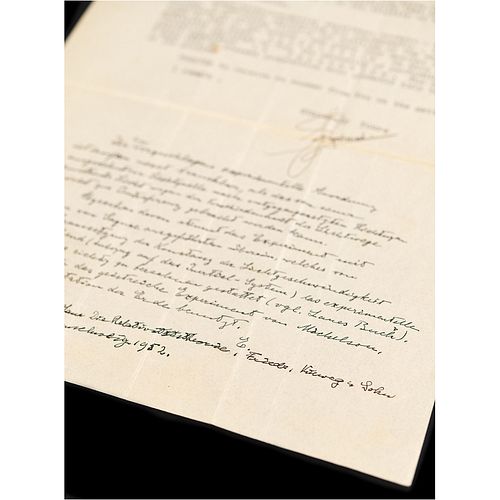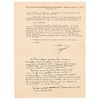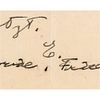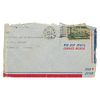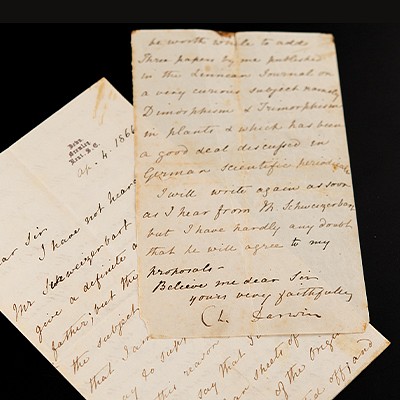Albert Einstein Autograph Letter Signed on the Special Theory of Relativity
Two ways to bid:
- Leave a max absentee bid and the platform will bid on your behalf up to your maximum bid during the live auction.
- Bid live during the auction and your bids will be submitted real-time to the auctioneer.
Bid Increments
| Price | Bid Increment |
|---|---|
| $0 | $5 |
| $50 | $10 |
| $200 | $25 |
| $500 | $50 |
About Auction
Apr 17, 2024
With nearly 900 lots up for auction, RR Auction's April Fine Autographs and Artifacts sale focuses on historic material from the 19th and 20th centuries. Among the highlights are a rare check signed by Abraham Lincoln; a significant Leon Trotsky publishing contract; important scientific letters by Albert Einstein and Charles Darwin; several remarkable naval manuscripts; and a historic letter by Martin Luther King, Jr. on the integration of higher education. RR Auction support@rrauction.com
- Lot Description
ALS in German, signed “E,” one page, 8.5 x 11.25, March 29, 1953. Handwritten explanation relative to the "constancy of the speed of light" and "rotation of the Earth" in experimental proofs of his Special Theory of Relativity, penned below an inquiry sent to him by George Aristotle Solounias. In concluding his letter, Solounias asks: "Dear Professor, Since Michelson-Morley experiment accepts—as I have proved—a newtonian explanation and consequently, it may be considered as proving directly the addition of the velocity of light to that of the source, and since Your Special Theory of Relativity is based essentially on this experiment, contrarily explained by You, the necessity of performing of a direct experiment is imperative. For this aim, I hope that my present proposition will probably help the solution of the problem."
Below, Einstein writes (translated): "The experimental arrangement proposed here is not useful in that the light emitted from an extended light source in opposite directions cannot be brought to a state of interference due to the difference in light paths. Apart from that, the experiment agrees with that carried out by Sagnac, which allows the experimental result to be calculated correctly based on the assumption of the constancy of the speed of light (with reference to the inertial system) (see Laue’s book). Compare it also with the ingenious experiment of Michelson, which needs the rotation of the Earth." He cites the referenced book below: "M. v. Laue, The Theory of Relativity, J. Friedr. Vieweg & Son, Brunswick, 1952." In fine condition, with light intersecting folds. Accompanied by the original mailing envelope.
In his letter to Einstein, Solounias evidently proposed an experiment to determine whether "the velocity of light is independent, or not, of the velocity of the source." He mentions the 'Michelson-Morley experiment,' conducted in 1887, which was an attempt to measure the motion of the Earth relative to the 'luminiferous aether,' a permeating space then thought to carry light waves. The experiment found exactly nothing—the two light beams, as measured by a sensitive interferometer, took precisely the same time to arrive at their destination. This result was the first strong evidence against some aether theories, and initiated a line of research that eventually led to Einstein's development of special relativity in 1905. He also references experiments performed by French physicist Georges Sagnac, who lent his name to the 'Sagnac effect' in 1913: a phenomenon that manifests itself when a beam of light is split and the two beams follow the same path in opposite directions, displaying interference when recombined. Sagnac concluded from his experiments that light propagates at a speed independent of the speed of the source, which is consistent with Einstein’s theory of relativity. German physicist Max von Laue, also referenced here by Einstein, had predicted the Sagnac effect theoretically in 1911. - Shipping Info
-
Bidder is liable for shipping and handling and providing accurate information as to shipping or delivery locations and arranging for such. RR Auction is unable to combine purchases from other auctions or affiliates into one package for shipping purposes. Lots won will be shipped in a commercially reasonable time after payment in good funds for the merchandise and the shipping fees are received or credit extended, except when third-party shipment occurs. Bidder agrees that service and handling charges related to shipping items which are not pre-paid may be charged to a credit card on file with RR Auction. Successful international Bidders shall provide written shipping instructions, including specified Customs declarations, to RR Auction for any lots to be delivered outside of the United States. NOTE: Declaration value shall be the item’(s) hammer price and RR Auction shall use the correct harmonized code for the lot. Domestic Bidders on lots designated for third-party shipment must designate the common carrier, accept risk of loss, and prepay shipping costs.
-
- Buyer's Premium



 EUR
EUR CAD
CAD AUD
AUD GBP
GBP MXN
MXN HKD
HKD CNY
CNY MYR
MYR SEK
SEK SGD
SGD CHF
CHF THB
THB